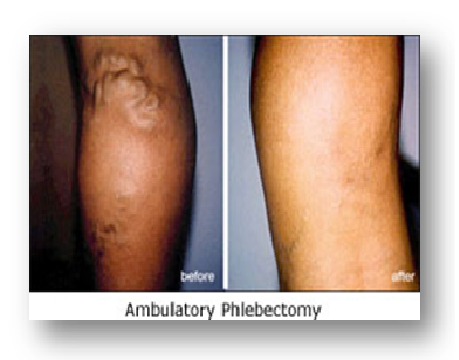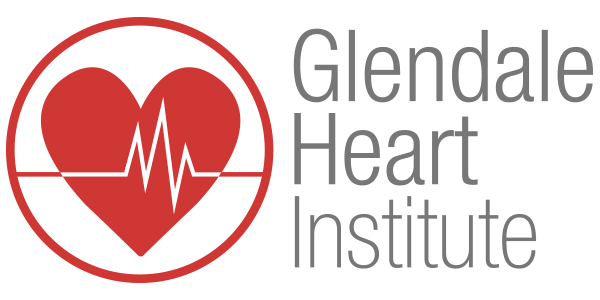Ambulatory phlebectomy is a method of removing varicose veins on the surface of the legs. It is done in the office under local anesthesia. This procedure involves making tiny punctures or incisions through which the varicose veins are removed. The incisions are so small no stitches are required. Veins are very collapsible such that even large veins may be removed through the tiny incisions used in this technique. The patient is able to walk following the procedure.
After treatment, a compression bandage and/or compression stocking are worn. Your physician willadvice you how long to wear any bandages or hose. Many physicians recommend that you walk or bike after treatment. This reduces pressure in the veins, increases the flow in the veins and reduces the risk of forming a blood clot.
After treatment, a compression bandage and/or compression stocking are worn. Your physician willadvice you how long to wear any bandages or hose. Many physicians recommend that you walk or bike after treatment. This reduces pressure in the veins, increases the flow in the veins and reduces the risk of forming a blood clot.

WHEN IS AMBULATORY PHLEBECTOMY APPROPRIATE?
Ambulatory phlebectomy may be used to remove both asymptomatic and symptomatic superficial veins from the skin. Typically, treated veins are the larger, bulging (raised) and varicose veins, although smaller veins may also be removed with ambulatory phlebectomy. This procedure is most commonly done with VNUS closure procedure.
IS AMBULATORY PHLEBECTOMY PAINFUL?
Ambulatory phlebectomy is performed under local anesthesia and patients should not feel any pain during the procedure. After surgery, discomfort should also be minimal to none, especially if compression stockings are worn as directed.
Ambulatory phlebectomy may be used to remove both asymptomatic and symptomatic superficial veins from the skin. Typically, treated veins are the larger, bulging (raised) and varicose veins, although smaller veins may also be removed with ambulatory phlebectomy. This procedure is most commonly done with VNUS closure procedure.
IS AMBULATORY PHLEBECTOMY PAINFUL?
Ambulatory phlebectomy is performed under local anesthesia and patients should not feel any pain during the procedure. After surgery, discomfort should also be minimal to none, especially if compression stockings are worn as directed.
WHAT ARE THE COMPLICATIONS OR POTENTIAL SIDE EFFECTS OF AMBULATORY PHLEBECTOMY?
Temporary bruising and swelling of the treated area is typical and is minimized with compression stockings. The small incisions heal well without sutures, and after six to 12 months, they are practically imperceptible. (Note: In darker-skinned patients, the incision sites may be darker-colored before fading.)
WHAT CAN I EXPECT AFTER HAVING HAD AMBULATORY PHLEBECTOMY?
Bruising and swelling is normal and temporary. You can walk immediately after surgery and carry on normal daily activities, except for exercise and heavy lifting. You must follow the activity restrictions and wear the compression stockings as directed by your doctor
Temporary bruising and swelling of the treated area is typical and is minimized with compression stockings. The small incisions heal well without sutures, and after six to 12 months, they are practically imperceptible. (Note: In darker-skinned patients, the incision sites may be darker-colored before fading.)
WHAT CAN I EXPECT AFTER HAVING HAD AMBULATORY PHLEBECTOMY?
Bruising and swelling is normal and temporary. You can walk immediately after surgery and carry on normal daily activities, except for exercise and heavy lifting. You must follow the activity restrictions and wear the compression stockings as directed by your doctor
Cardiac Specialty Care
• Structural Heart Disease
• TAVR Aortic Valve
• Cardiomem - Heart Failure
• Coronary Disease
• TAVR Aortic Valve
• Cardiomem - Heart Failure
• Coronary Disease
• Complex total Occlusions
• Stent and PTCA
• Atherectomy
• Cerebral
• Stent and PTCA
• Atherectomy
• Cerebral
• Carotid Stenting
• Peripheral Arterial
• Atherectomy-Stent-Thrombectomy
• Peripheral/Venus - Ablation - DVT thrombectomy - IVC filter
• Peripheral Arterial
• Atherectomy-Stent-Thrombectomy
• Peripheral/Venus - Ablation - DVT thrombectomy - IVC filter
• Rhythm Management
• Pacemaker
• Resynchronization Therapy
• EECP- Enhance electrical Counterpulsation
• Pacemaker
• Resynchronization Therapy
• EECP- Enhance electrical Counterpulsation
